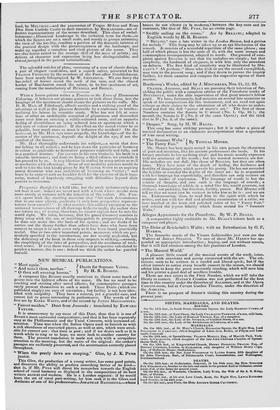When a house-painter writes a Treatise on the Laws of
Harmonious Colouring, it behoves our picture-painters to look about them, lest the hangings of the apartment should shame the pictures on the walls. Mr. D. R. HAY, of Edinburgh, affords another and a striking proof of the advantage as well as the pleasure derivable by a craftsman in intellec- tualizing his labour by scientific study. ' Who has not felt at sonic time or other an undefinable sensation of gloominess and discomfort come over him on entering a coldly-coloured room, and an opposite feeling of cheerfulness on being ushered into an apartment which a rich tone of colour pervades ? If the effect on the casual visiter be so palpable, how much more so must it influence the resident ? On the taste—or, as Mr. HAY says more properly, the knowledge—of the de- corator of the apartment, depends the delight of the eye, if not the comfort of the inmate.
Mr. HAY thoroughly understands his subject,—a merit that does not belong to all writers ; and he lays down the principles of harmony in colour as applicable to decorative purposes explicitly arid fully, and in a practical manner. For persons in his own business, his book is a valuable instructor ; and from its being a third edition, we conclude it has proved to be so. It may likewise be studied by many artists as well as mechanics with advantage. Some of our mediocre painters would do well to take the hint kindly given by Sir WALTER SCOTT to an aspiring young decorator who was ambitious of becoming an "artist ; " and learn to be content with an humbler field for the exercise of their inge- nuity, instead of hopelessly struggling with difficulties beyond their powers to overcome.


























 Previous page
Previous page